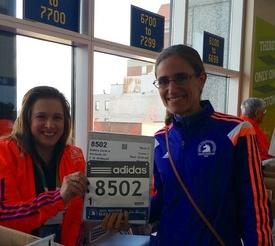Running question: Does form and technique really matter?

sciullo779
Posts: 12 Member
Ive read for the past few days the way to "properly" run is to strike midfoot to the ball of your foot and just touch briefly with your heel, along with never keeping your legs totally straight, and making sure to bring your foot up past the height of your knee every step.
As someone looking to start running with a C25K and naturally heel strikes, does this all hold true? or should I just run how im comfortable?
As someone looking to start running with a C25K and naturally heel strikes, does this all hold true? or should I just run how im comfortable?
0
Replies
-
Just run in whatever form keeps you comfortable. If you start getting more "into" it and trying to go faster you can start thinking about that sort of thing. Until then though, just go out and run.0
-
I agree--just go out and run. If you start having a problem, you can work on changing your form or breathing or whatever. But I wouldn't worry about it at this point.0
-
I don't agree with bringing your foot up that high. My favorite advice when I was a new runner was to pretend that you are running alongside a shoulder-height hedge, and that someone on the other side of the hedge is watching you. They should not see your head bobbing up and down, but going relatively straight. I was also told to try and concentrate on a mid-foot strike with shorter strides in the beginning and that worked really well for me. Do what works but keep in mind that when you do try and change your form you'll be working to unlearn a lot of muscle memory.0
-
Feet higher than the knees? Somebody is leading you wrong, I'm sure. Not that I am an expert on running, but that sounds terribly unnatural. The only people I could imagine needing to raise their feet that high during their stride would be Olympic sprinters, but looking at imagery of Olympic sprinters it looks like not even they raise their feet that high.


You might just be getting advice from an asshat.0 -
sciullo779 wrote: »and making sure to bring your foot up past the height of your knee every step.
i am training for a 10k at the moment and i'm pretty sure my foot has NEVER come up that high...
0 -
-
I started running with C25k in June and now run daily. The reason I was able to get to this level as quickly as I did is because I followed all of the tips and advice that is out there for beginning runners. You DO want to have a midfoot strike - it's so much easier on your knees, shins, heels, ankles, etc. You want to have a short stride, but a faster cadence. When you run, your foot should land directly below your knee - Look at these Olympic runners[/url every single one is leading with their knee, and not bringing the foot in front of them. It allows your muscles, bones, joints to have a greater endurance which is more important than speed. You want to stand almost straight up, but lean forward and take out as much bounce out of your run as possible.
I know it seems picky, but once I started paying attention to my form, I went from one day being able to barely do 30 minutes, to the next time I ran, I fell very comfortably into proper form, and went for a full hour without pain! It was amazing. Read every single article that is out there on beginner tips - drill that into your head, they don't all the same things because it's a mass conspiracy...it's because it's truf! 0
0 -
And clearly I don't know how to use hyperlinks. Le sigh.0
-
There are pros and cons on this. Certainly improving my running technique and form has been a huge part of my fitness journey - running is more enjoyable for me, with a smoother feel, I am faster, and less injury prone. But it's trickly to go making changes to your mechanics without expert supervision - you can easily make things worse by thinking mechanical thoughts while you run and forcing your body into unfamiliar movements.
Rather than specifically trying to change your mechanics, there are some good drills and exercises you can do that will "naturally" help your technique. One of the best is 100 ups - it's very simple, it's definitely not going to hurt you, and it can help you get the feel of improved form. http://100up.info/the-100-up-running-technique-2
Beyond these kind of simple things, I wouldn't do too much monkeying around with your mechanics without input/supervision from a good coach.0 -
sciullo779 wrote: ».... or should I just run how im comfortable?
Run how you're comfortable. I find a short, rapid, pace works best for me as it's sustainable for a long time.
It sounds like you were given advice on sprinting, which isn't sustainable.
0 -
I would Google chi running & pose running. While I believe that "proper" running form can prevent a lot of injuries, I also know that from experience, people can run with terrible "form" and have no problems.0
-
Yes! Chi running! I second that suggestion, as well!0
-
The only potential problem with the "just do it and not worry about form" suggestion is that you could get used to running with bad form and become injured. I had a stress fracture in my left knee (that hurt like he**, I will add) from overstriding which was due to heel striking. I had to work really hard to change my stride/form. Just my $.02.0
-
Basically this is what Im talking about.
youtube.com/watch?v=XrOgDCZ4GUo0 -
LeanButNotMean44 wrote: »The only potential problem with the "just do it and not worry about form" suggestion is that you could get used to running with bad form and become injured.
Whilst in principle I'd agree, in practice someone starting a C25K plan will take some time to find their form. At that point it's worth starting to do something about whether it's right or not.
Give someone on week one of C25K too much to think about, they'll never make it into week two.
0 -
Last year my daughter was a leg straight out in front of her runner because no ever fixed her form. She spent 10 weeks in a boot with a severe achilles tendon problem. This year the trainer at school spent weeks working with her on the form and pushing the concept of the majority of her body being over her foot as it touches the ground. He also stressed shorter more rapid strides for everything but her last 200 meters (she's a XC runner). Fingers crossed no issues with the achilles anymore and she just PR'd her 5K this weekend after missing the first 2 meets this year while in PT because the tendon issue had started again.0
-
how is the akward runners video not up here yet???
because yes there are ways to be run more efficiently and improve speed and distance- and very importantly: reduce injury.
But- most of those things can be sorted out after you get some actual miles under your belt, all the form in the world won't help you if you don't have the lung capacity or strength to run a mile in the first place.
I wouldn't over think it when you're just getting started- as there is a fair bit of "just go do it" that should happen- but at some point you can stop and say- how can I be doing this better.0 -
unless you are experiencing discomfort in your feet, ankles, knees or lower back, i wouldn't bother to mess with your natural mechanics0
-
I would say enjoy yourself, don't overthink it! After you learn to enjoy it, you can tinker with your form and see what works for you based on your goals.0
-
-
Go out and run, then deal with the details after you can actually run.
Also, might want to rethink that heel strike eventually. It was definitely unkind to me.0 -
For the most part, run how you are comfortable. The only thing I would watch out for is overstriding.
And I wouldn't worry too much about your foot strike.
http://www.runnersworld.com/injury-prevention-recovery/large-us-army-study-foot-strike-doesnt-affect-injury-rate0 -
missed the part about feet higher then the knees. I've never heard that before (also not a runner) but if it applies to anything its flat out sprinting, like 100m or less. Not even a middle distance runner would run like that0
-
I wouldn't worry about the midfoot vs heel thing as much as making sure that if you are heel striking that your heel is landing mostly underneath your body and not in front. That will make a difference for sure. I think a lot of the issues with heel strikers is that they hit the ground with their heel in front of their body.0
-
yea agreeing with what everyone is saying...dont focus so much on the foot strike if its working for you...however dont overstride...keep your head up and shoulders straight..dont cross your chest with your arms..all these will help with your efficiency.0
-
This for sure. Takes practice but makes a big difference.handyrunner wrote: »yea agreeing with what everyone is saying...dont focus so much on the foot strike if its working for you...however dont overstride...keep your head up and shoulders straight..dont cross your chest with your arms..all these will help with your efficiency.
0 -
If you're getting into competitive sprinting then it definitely matters as you can drop time with better form. Does it matter for long-distance I couldn't say for sure as I haven't studied distance running much but it might to some degree. Something like bringing your foot up to your waist sounds more like a running drill to focus on form and striking your foot correctly. I would suggest keeping your arms at a 90-degree angle as you're running and go back and forth. Find your stride and practice maintaining that same stride as you run so it's consistent.0
-
Proud heel striker here; I would concentrate more on upper body form and go with "not broke, don't fix it" principle for the feet. If you are running comfy and all is well in the lower limbs, concentrate on your arms if you really want to fix some aspect of form. Don't cross over the chest, don't let them hang at your sides or below the waist, don't swing up by your ears.0
-
Form is most important for distance or competitive runners. If you're just looking to ramp up your exercise regimen, it's not the be all end all. Proper form does however help protect you from injury, just like having the right shoe does.
You'll know if you're running wrong. You'll be in pain in a place you shouldn't (inside of the hip for me) or you'll roll your ankle etc.
Your form will improve to a degree over time; your body really does want to move in the most effective and efficient way possible. If you have problems, trouble shoot. I underpronate, which causes the pain in my hip, so if I start to feel that early in a run, I will literally spend my run focusing on correcting how my foot is going through the motion and keeping my weight to the middle of it. I know there's shoes I could buy to help me do that, but since I'm broke, I'll just use the mental focus for now.0 -
This discussion has been closed.
Categories
- All Categories
- 1.4M Health, Wellness and Goals
- 398.2K Introduce Yourself
- 44.7K Getting Started
- 261K Health and Weight Loss
- 176.4K Food and Nutrition
- 47.7K Recipes
- 233K Fitness and Exercise
- 462 Sleep, Mindfulness and Overall Wellness
- 6.5K Goal: Maintaining Weight
- 8.7K Goal: Gaining Weight and Body Building
- 153.5K Motivation and Support
- 8.4K Challenges
- 1.4K Debate Club
- 96.5K Chit-Chat
- 2.6K Fun and Games
- 4.8K MyFitnessPal Information
- 12 News and Announcements
- 21 MyFitnessPal Academy
- 1.5K Feature Suggestions and Ideas
- 3.2K MyFitnessPal Tech Support Questions




















